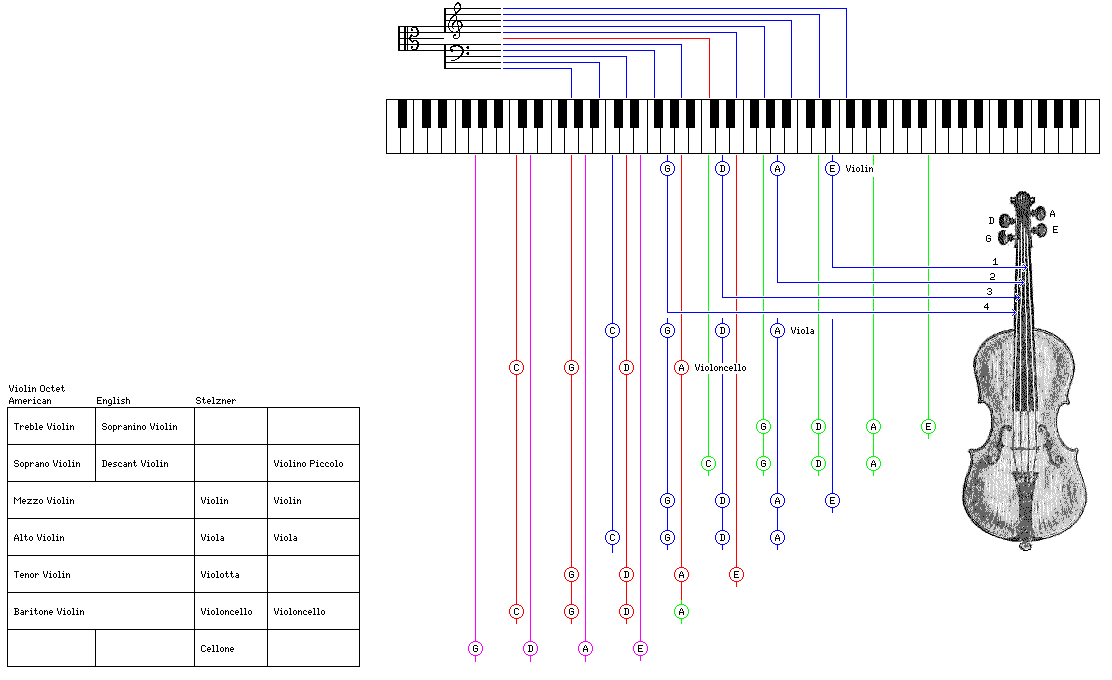
The diagram below illustrates the notes played on the open strings of the violin, and also for two other members of the violin family, the viola and the cello.
The strings of the violin are tuned a fifth apart, as is true for those of the other instruments described in this diagram; those of the double bass are tuned a fourth apart, so it and related instruments are described in another diagram.
In addition to the violin, viola, and cello, the tunings for six of the eight instruments in the Violin Octet of Carleen Hutchins are shown in this diagram.
An earlier proposal for additions to the violin family, by Dr. Alfred Stelzner, is also noted in this diagram. He had also proposed a change in the shape of the instrument to improve its acoustic properties; among other things, the difference in size between the upper and lower halves of the body was increased slightly.

The violin family as we have it today does present some difficulties.
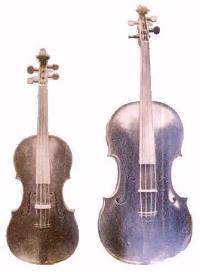
This image which I produced from an old photograph of a violin and a viola side by side shows that the viola is quite a bit larger than the violin. However, the viola is tuned a fifth lower than the violin; it may be larger, but it is not one and a half times larger in every direction.
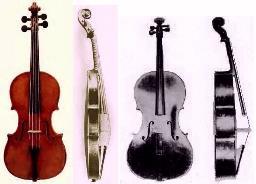
On the left, there are images of the front and the side of a violin, from an old photograph; on the right, images of the front and side of a cello, from another old photograph.
The images are not to the same scale; for comparison, the two instruments have been made the same height, whereas a cello is in fact much larger than a violin.
As can be seen from this image, a cello is considerably thicker, in proportion to the size of its front and back, than a violin.
This was done to increase the internal volume of the cello, thus lowering some of its resonant frequencies, while limiting its size.
So what is illustrated here is that the wide range of musical pitch, of audio frequency, covered by the violin family cannot be matched by a proportionate increase in size, because the awkwardness of having larger instruments is not felt to be a reasonable disadvantage to accept for the improvement in tone that would be obtained. Of course, since the cello exists, a larger viola that would have to be played like a cello could still be played; and since the double bass exists, a cello that has a larger front and back, but more violin-like proportions, again, could still be played; but in both cases, making the instrument larger would limit what players could do with it in performance, and it would make it awkward to seat as many players of each instrument in an orchestra.
So a balance was found between the notes each type of instrument would produce and how much of the agility of a violin player performers in that range of sound would need to enjoy for the purpose their parts would serve in music.
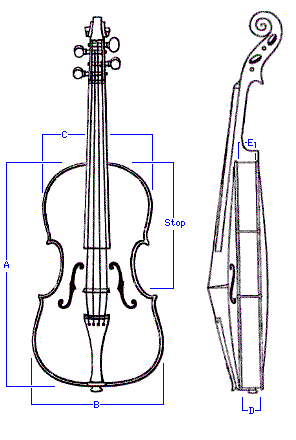
To allow a clearer comparison of the sizes of the violin, the viola, and the cello, the diagram on the right shows several dimensions of such instruments, following the notation used in the book Antonio Stradivari: His Life and Work by W. Henry Hill, Arthur F. Hill, and Alfred E. Hill. This book included, as an appendix, tables of the dimensions of a number of instruments by Stradivari and others.
Here are just a very few of the measurements given there, to give an idea of the relative sizes of these three instruments:
A B C D E Stop Violin 14 1/16 8 1/4 6 5/8 1 1/4 1 3/16 --- Stradivarius, 1720 Violas 18 7/8 10 3/4 8 5/8 1 11/16 1 9/16 10 1/4 Stradivarius, 1690 (Large size) 16 3/16 9 9/16 7 5/16 1 1/2 1 7/16 8 5/8 Stradivarius, 1701 (Small size) Cellos 31 3/8 18 1/2 14 1/2 4 3/4 4 1/2 16 3/4 Stradivarius, 1690 (Tuscan) 29 7/8 17 3/8 13 5/8 4 5/8 4 1/8 15 3/4 Stradivarius, 1711 (Duport)
The Duport cello, being made after 1710, is an example of one made using the "Forma Buono" cello mold, and these proportions are now considered the ideal for a cello.
The large size viola listed above, however, may be a tenor viola, that is, an instrument intended to be an octave below the violin rather than a fifth, since the size given corresponds to that of an instrument from 1690 by Stradivarius now referred to as a tenor.
Metal-wound strings are not a recent innovation; they were what enabled Francesco Ruggieri to reduce the size of the cello to what we are familiar with today, to sizes such as 760 mm and 740 mm. The body size of cellos was originally around 32", or 812 mm. As can be seen from the table above, Stradivarius made cellos in both of these ranges of size. Guadagnini went further, making cellos with a body size as small as 711 mm or 28", and this would still be considered a full-size cello today.
Given that the smaller pattern of cello required the use of metal-wound strings, which were a new innovation in Stradivari's day, it is not surprising that he is noted not to have begun making the smaller type of cello until after many other Cremonese makers had done so. This is one detail which helps to confirm that Stradivari, who is reputed to have made the best-sounding string instruments ever, was genuinely concerned with their sound, and that it wasn't simply a happy accident that happened to a maker chiefly concerned with making instruments with very good looks. Of course, a naïve person like myself would tend to say that we hardly needed any such confirmation, but such is the controversy swirling around Stradivari that any facts are helpful.
As for the viola, current violas are all in the "small size" class. If the size of a viola were in proportion to its pitch, it would have a body size of 21 3/32 inches, and a thickness at its base of 1 7/8 inches, which would be completely impractical, unless it were to be played as a cello is played.
Using sizes from the table above, which don't necessarily correspond to the actual instruments the old pictures of which were used in preparing this image, here is an image providing a graphical comparison of the size of a violin, a viola, a tenor, and a cello:
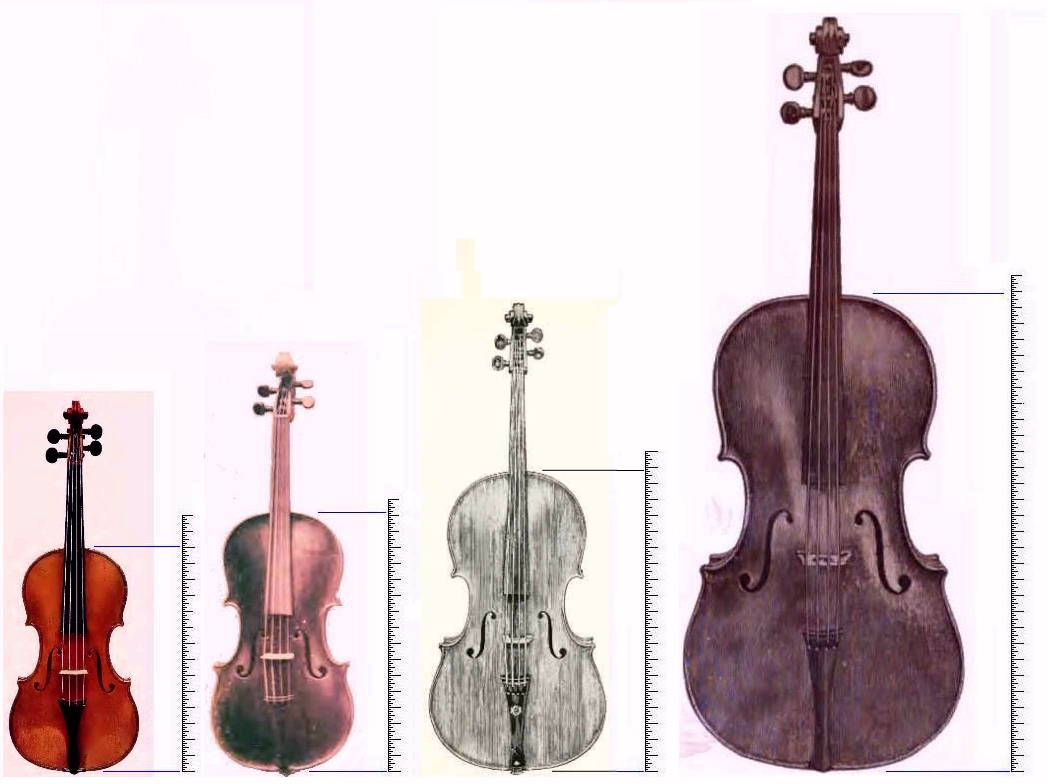
The tenor has corresponding strings one octave lower than those of a violin; the one depicted here has a body about 18 13/16" in length. Thus, it appears to be an instrument that is as large as an instrument intended to be played under the chin like a violin or viola could possibly be - and that if one disregards the hazards of long-term use, which, of course, were not as well known in 1690 as they are today in our medically-aware and safety-conscious age, so a criticism of Stradivari is not intended (this being an image of a drawing - an engraving taken from a photograph - of the tenor from the "Tuscan" quintet, the other instruments here being represented by actual photographs).
If a cello were made as a scaled-up violin, its body height would be 42 3/16 inches, but the thickness at its base would only be 3 3/4 inches, less than that of today's cellos, which indeed, as noted, use a larger depth as a substitute for a full height.
Looking at an adult playing a cello, one might think that there would be no problem in making a cello in that larger size resulting from maintaining the same proportions as a violin, since the metal rod reaching down to the floor from the bottom of the cello, called the pin, is certainly much more than one foot in length. However, this would also enlarge the distance between the points at which the fingers would have to press the strings to the fingerboard to play different notes. To reduce this distance is the reason Francesco Ruggieri took the opportunity afforded by the development of metal-wound strings to reduce the body size of a cello from about 32" to 29", so a cello with a 42" body would clearly be impractical. This is also the reason why the strings on a double bass are tuned in thirds rather than in fifths, so that fewer notes need to be made with any one string.
Of course, one could imagine a cello of this form being made with its strings tuned an octave higher than the strings of a double bass. The lowest note that could be played would be E instead of C, but it would cover much of the same range.
A viola that was a scaled-down cello instead of a scaled-up violin would be 14 15/16 inches in height, but 2 5/16 inches thick at the base; perhaps such an instrument is too thick to hold under the chin, but as there appears to be room to put a shoulder rest under a viola, perhaps not.
Note that all three instruments are slightly wedge shaped, being thicker at the bottom than at the top (in the sense of towards the neck, not towards the belly).
Although the diagram above shows the names for the instruments proposed by Stelzner, it omits those in another proposal for filling some of the gaps in the violin family.
Fred L. Dautrich, in the United States, proposed a vilonia, which was a viola having a 20 inch body and played like a cello, a vilon, with the tuning of the tenor viol, and which resembled a 1/2 cello, and a vilono, tuned like Stelzner's cellone, two octaves below the violin.
His work was cited by Hutchins as providing important assistance in the initial design of the Violin Octet.
These names inspired me to double-check; it turns out the violin, the viola, the violoncello (usually just called the cello) and the double bass (also known as the contrabass) are, respectively, violono, aldviolono, violonĉelo, and kontrabaso in Esperanto. (Instead of violonĉelo, I've tended to encounter the X-system spelling violoncxelo online.)
The diagram below shows the tunings for the double bass and related instruments.
Shown there in addition are the two remaining members of the Violin Octet, and the Octobass, proposed by the noted luthier Jean-Baptiste Vuillaume.
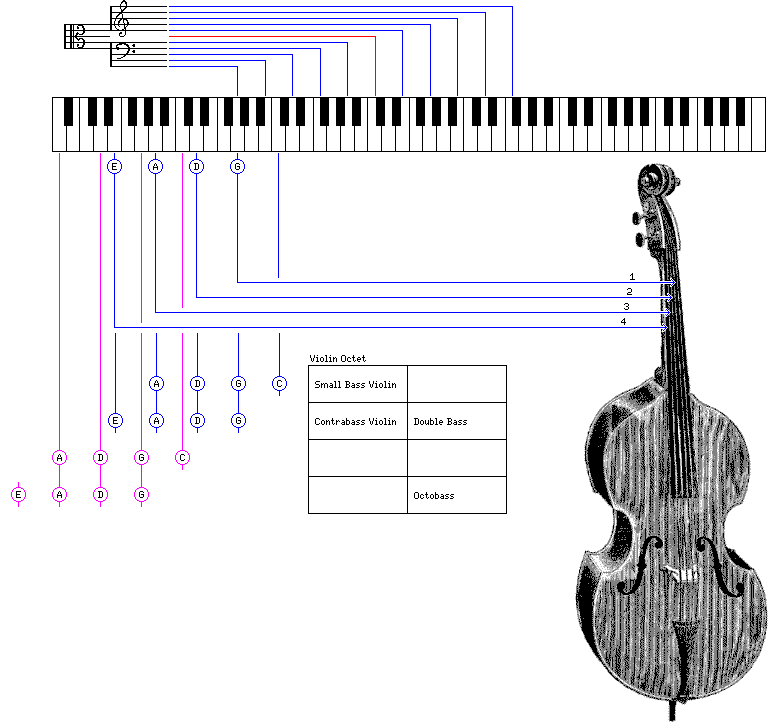
The charts above show what notes are played with the open strings on the various instruments of the violin family. Of course, on each string, higher notes are played by using the fingers (normally, of the left hand) to press strings against the fingerboard to effectively shorten them.
Violins don't have frets, and so it takes practice and training for a musician to place his or her fingers in the right place quickly, and a good ear as well to quickly make fine adjustments.
Moving the hand from one position to another along the fingerboard takes a little time, plus the time required to zero in on the correct pitch for the next note played.
In the case of the violin, the notes at the different positions on the string, and the conventional positions for the hand are shown below:
G D A E Open String G# D# A# F 1 2 3 4 5 6 7 8 9 X Y A E B F# * A# F C G | * B F# C# G# * | C G D A * * * C# G# D# A# | | | D A E B * * * * D# A# F C * | | * E B F# C# * * | F C G D * * * * F# C# G# D# | | | G D A E * * * * G# D# A# F * | | A E B F# * * * A# F C G * | | * B F# C# G# * * | C G D A * * * * C# G# D# A# | | | D A E B * * * * D# A# F C * | | E B F# C# * * F C G D * * F# C# G# D# | G D A E * G# D# A# F
The letters X and Y are used to denote the tenth and eleventh positions. Some works by Dvorak and other relatively modern composers do use the eleventh position, and even higher positions exist, at least in theory. But it is positions up to the seventh that are considered usual and commonplace.
For the 1st, 3rd, 4th, and 7th positions, the asterisks (*) indicate where the fingers might actually be to make notes belonging do the diatonic scale of the key of C on the G string.
Of course, the fingers would be moved to other positions depending on which string is in use and in which key is the music being played.
For the 2nd and 5th positions, the E string (and, in the case of the 2nd position, the A string as well) has its diatonic notes in the positions marked by asterisks.
For the 6th position, the asterisks show diatonic notes, the notes made by the white keys of the piano with plain letter names, on the D and A strings.
The eighth, ninth, tenth, and eleventh positions may be viewed as analogous to the first, second, third, and fourth positions respectively. As the fingers are moved to higher notes on the fingerboard, and they are moved towards the body of the violin, they also are placed closer together - as these four positions play notes an octave higher than those played in the first four positions, the fingers are only half as far apart.
Thus, the marked positions, whether filled with an asterisk (*) or a vertical line (|), show places where the fingers might be. In the case of the violin, at least, it would be more accurate to place a vertical line beyond the positions marked from asterisk to asterisk at both ends; for the other instruments, which are larger in size, and demand the hand to cover more space per note, that is not the case.
With the hand settled in any one of these positions, the important point is that just by moving an individual finger from its position to the next adjacent one, without moving the hand, eight spots along the string are accessible, and so a continuous scale of notes can be played across all the strings of the instrument, as the strings are tuned in fifths, and a fifth is seven semitones. So the four fingers of the left hand only need to cover six positions on each string for there not to be gaps between the notes playable on one string and the next one higher.
Initially, when I encountered the Violin Octet of Carleen Hutchins, while it seemed reasonable enough to bring back the Tenor Violin to fill a gap, even if orchestras seemed to be getting along quite well without it, I wondered why the Treble Violin and the Soprano Violin were also included. Given the use of the higher hand positions on the violin, which present challenges for the performer, the reason becomes obvious.
If there is a Treble Violin section of the orchestra, they can play, in their first four hand positions, the music that would require the violinists to play in the eighth, ninth, tenth, and eleventh positions.
And the musicians performing on the Soprano Violin, using their first four hand positions, can perform those parts of the score which require the violinist to use the fourth, fifth, sixth, and seventh positions.
One musical work noted as making extensive use of the eleventh position of the violin is Antonin Dvorak's Symphony in G major, opus 88.
In the case of the viola, the sequence becomes:
C G D A Open String C# G# D# A# 1 2 3 4 D A E B * D# A# F C | E B F# C# * * F C G D * * * F# C# G# D# | | | G D A E * * * * G# D# A# F | | | A E B F# * * * A# F C G * | B F# C# G# * C G D A * C# G# D# A# D A E B
Despite the fact that the viola is significantly larger than the violin, the fingering is similar, although there are fewer hand positions available. The hand, at least, can stretch to cover six notes, and so once again any scale is possible in a single hand position.
The first position on a viola is analogous to the fourth position on a violin, but an octave lower, and so the sequence can be continued. I've see a web site with charts for positions up to the eleventh position on the viola; however, the viola's neck is proportionately shorter, in relation to its body, than that of a violin, and thus it would appear to me that fewer positions must therefore be available on the viola. However, I have seen a reference to one work, a viola duo by A. Rolla, which makes use of the eleventh position on the viola.
The difficulties posed by higher hand positions on the viola have led to the modified viola of Otto Erdész from the decade of the 1970s.
Perhaps, despite it being even bigger, the first four of the violin's hand positions can be attempted on the tenor.
The cello is the same, only an octave lower:
C G D A Open Strings C# G# D# A# 1 2 3 4 D A E B * D# A# F C * E B F# C# * * F C G D * * * F# C# G# D# * * G D A E * * * G# D# A# F * * A E B F# * A# F C G * B F# C# G# C G D A
But in this case, four consecutive semitones represent the normal positions of the fingers, as the cello is much larger than the viola. Still, apparently it is still possible to move the fingers at each end up or down a fret, so that it may perhaps not be necessary to shift the hand to play a complete scale.
Although, even if that were possible, it would certainly be difficult, and so a composer should not write for the cello (or even the viola) as if it were as facile (easy is hardly the right word) to play as a violin.
In the case of the double bass,
E A D G Open String F A# D# G# 1 2 3 4 5 6 7 F# B E A * G C F A# * * G# C# F# B * * A D G C * * A# D# G# C# * B E A D * * C F A# D# * * C# F# B E * * D G C F * * D# G# C# F# * E A D G * * F A# D# G# * F# B E A *
it's as much as the hand can do to stretch to play three different semitones on each string. Since the strings are tuned in thirds rather than fifths, only four semitones rather than six need to be covered on each string to allow a complete scale to be played in a single hand position. And, since in playing scales, the notes not on the diatonic scale are skipped, perhaps a suitable hand position for the key in use will put only unused notes in the inaccessible positions.
Not shown are the 1/2, 2 1/2, 3 1/2, 5 1/2, and 6 1/2 positions, which cover the possibilities not assigned to one of the traditional 7 positions shown on this chart.
The 1/2 position, one semitone lower in pitch and one (nonexistent) fret upwards towards the scroll in terms of hand position, is also defined for the other instruments.
In the charts above, the instruments in Carleen Hutchins' Violin Octet have simply been noted in terms of the positions they occupy on the scale due to their tunings.
Originally, the Small Bass Violin and the Contrabass Violin were tuned in fifths, like the instruments from the violin to the cello, but this was changed when it was recognized that fingering large instruments in a high position presents difficulties, and so they were changed to be tuned in fourths like the double bass.
The Mezzo Violin, the Alto Violin, and the Baritone Violin are all somewhat larger than their conventional counterparts, the violin, the viola, and the violoncello. While the instruments of the violin octet are not strictly scaled up from the violin, because this would result in instruments much too large to be practical in some cases, they were designed so that their sizes would at least be in a consistent relationship to their pitches, with the sound quality being compromised in a gradual and uniform manner as the pitch became lower and the instruments larger.
Initially, it was assumed that a new instrument would not need to be designed to take the place of the violin in the Violin Octet. When it was found, however, that the other instruments in it were more powerful than even the best violins, the Mezzo Violin was designed. Initially, it was 14% larger in linear scale than a regular violin. This was found to give it more power than the other members of the group, and so this was adjusted to 8% larger so that all the instruments would be well matched.
Over the years since it was originally invented, changes have been made in the design parameters of the ensemble of instruments in response to advances in acoustical understanding.
Even quite recently, some of the strings on some of the members of the violin octet prersented difficulties, placing restrictions on the string lengths of some instruments because they had to provide a pitch either higher or lower than had been obtained from strings of their length before. New string types, sometimes made of special materials, were needed.
I do myself tend to think it is unfortunate, at least, that the Tenor Viola is no longer a commonly available choice of musical instrument. And many people have been favorably impressed by the sound of the instruments in the Violin Octet.
But, unfortunately, it is hardly surprising that this idea, as well as its predecessors, has failed to take the world by storm. The Tenor Viola, in its original form as a 19 inch instrument, played from the chin, was difficult to play; but it primarily fell into disuse simply because composers did not make much use of string instruments for the range of notes for which it would be the best instrument.
The Violin Octet includes a better-sounding viola that has to be played like a cello. Some composers make the mistake of writing for the viola as if it were a violin, writing music that is difficult to play because the notes on the strings of a viola are farther apart. But when a composer writes music that can be played properly on a 17" viola, the same problem will arise if someone tries to play that music on a 20" viola.
Thus, other approaches to an improved viola, such as the Pellegrina, have the goal of reducing repetitive strain injuries by making an instrument with the same string length as a 14" violin, and yet the sound of a good viola, by extending the instrument's internal volume in unusual directions that are available.
While that is the approach I would prefer, it isn't taking the world by storm either, although it at least has the advantage of not requiring new music to be written. Of cuorse, one can look at existing music to find, for exaple, cello parts that don't make use of the lowest notes on the cello, and which might sound better if played on a tenor, so in some cases, simply modifying the arrangement or orchestration of works would give that instrument something to do.
Next, we will look at how the viol was tuned; as it is a more complicated case, it may be appropriate at this point to look into the basis on which tunings are designed.
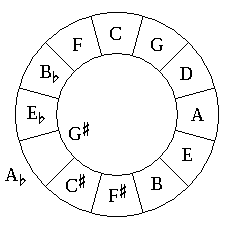
Above is a simple diagram of the circle of fifths, a very important concept in Western music as it is today.
Because the seven natural notes are consecutive on the circle of fifths, when strings are tuned a fifth apart - or a fourth apart, since that interval is complementary to the fifth, corresponding to a counter-clockwise step around the circle of fifths, as a fifth is a clockwise step - many choices of tunings are available which avoid having any open strings tuned to a sharp or flat.
A four-string bass guitar is tuned to the same four notes as a double bass. But bass guitars can also have five or six strings; the six string bass guitar extends the sequence of notes to B E A D G C, with another fourth available in both directions that leads to a natural note.
A six-string instrument tuned in fourths could also start the sequence at E, for E A D G C F, again using only natural notes.
Thus, based on that principle, one could have a whole family of six-stringed instruments, two per octave, with the space between them alternating between a fourth and a fifth.
For comparison with the tunings of the two parts of the violin family, here is a diagram of the tunings for the viol family, which preceded the violin family:
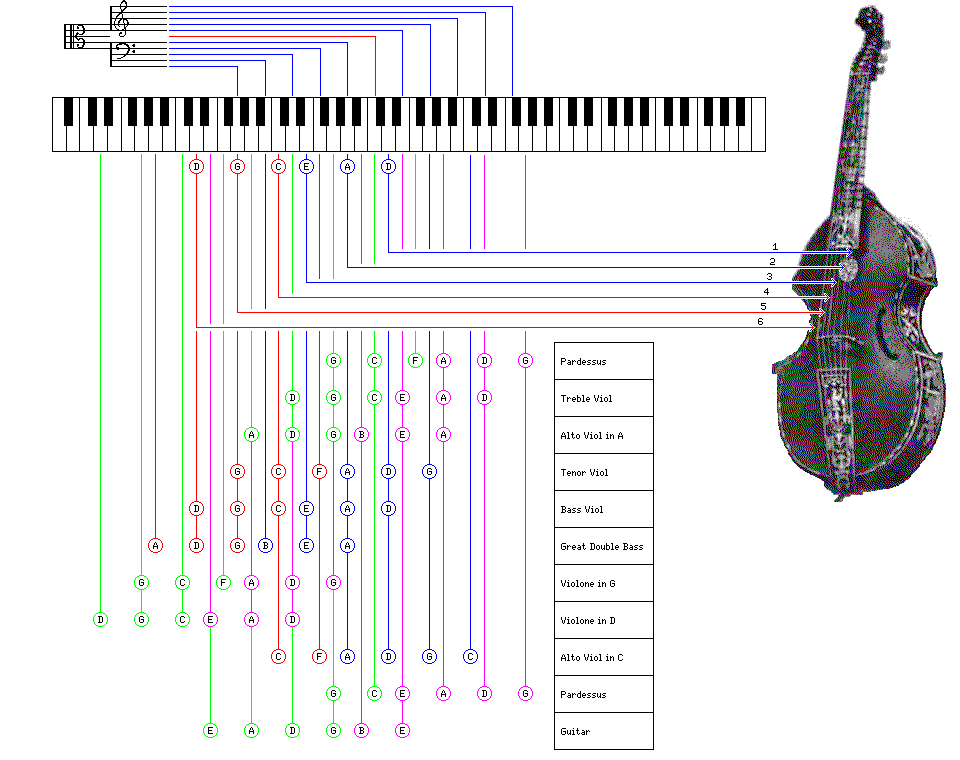
The tuning for the Great Double Bass is a presumed one given in Wikipedia.
That tuning is also the normal tuning used for a 6-string bass guitar.
A five-string bass guitar usually uses the lower five notes of these six, but a five-string tenor bass guitar uses the higher five notes of these six.
Most bass guitars, though, only have four strings. A normal bass guitar uses the middle four notes of those six, and a four-string tenor bass guitar uses the higher four notes of those six.
Note that the six strings of a viol are divided into two groups of three strings that are tuned in perfect fourths, like those on the double bass and related instruments, separated by a major third between the two central strings, and, as well, this is also true of the six-string bass guitar, unlike the case of plain guitars.
This allows three different instruments in each octave, and the compass is less wide than a straight tuning in fourths over six strings would provide; this is reasonable, as one reason violins only have four strings is the same as the reason the members of the violin family differ in size: a given instrument of a particular size produces the best quality of sound for notes within a limited range of pitch.
While the violin family consists of three instruments that follow one pattern, and a fourth instrument that differs, the viol family includes seven instruments that all follow the same pattern. But because the successive instruments are separated by fourths instead of fifths, and the conventional violin family omits a possible instrument between the viola and the violoncello, the range of notes covered is about the same.
Since the sixth string is tuned to the same part of the scale as the first string, it is possible to see that the possible tunings of this instrument correspond to the possible tunings for an instrument with five strings, all tuned in fourths.
Additional members of the viol family which don't fit into the regular pattern of those appearing here are shown at the bottom of the diagram. An instrument higher than the treble viol, the Pardessus, added at a late date, usually had only five strings. The Wikipedia article on the Pardessus shows two possible tunings for the six-string version, both the one which doesn't fit the pattern, shown at the bottom of the diagram, and the one that does; the article on the Viol only showed the one that didn't.
The Alto Viol in C, like the non-conforming Pardessus, had two strings tuned in perfect fourths, followed by a major third, followed by four strings tuned in perfect fourths, proceeding from the lowest string. In the case of that instrument, however, the deviation from the pattern was required, since the string tuned to A, if it was a perfect fourth higher than the one tuned to F, would be tuned to A sharp or B flat, not to B natural - and having open strings tuned to notes other than the natural notes of the diatonic scale seems to be something that is generally avoided.
As well, the standard tuning for the guitar is shown on this diagram, although it is plucked only and not bowed, because its tuning is also very similar: in this case, four strings tuned in fourths, a major third, and then two strings tuned in fourths. This time, the major third comes earlier rather than later, but it can be seen that the tendency to tune a six-stringed instrument in fourths with a major third near the center has survived the eclipse of the viol.
Incidentally, the diagram shows the actual pitch of the notes played on the open strings of the guitar. Normally, music written for the guitar is written an octave higher than this, so that the familiar treble clef can be used for it.
I can't really advance this proposal too seriously; if the Violin Octet is not achieving any traction, something that requires players to learn how to play the instrument all over again is hardly going to generate enthusiasm.
It would be possible to design a series of instruments, each of which has five strings, tuned in fourths, that would fill the roles of the instruments of the violin family.
CDEFGABCDEFGABCDEFGABCDEFGABCDEFGAB
G D A E - Violin
C G D A - Viola
G D A E - Tenor Viola
C G D A - Cello
E A D G - Double Bass
G C F A D G - Pardessus
D G C E A D - Treble Viol
A D G B E A - Alto Viol in A
G C F A D G - Tenor Viol
D G C E A D - Bass Viol
A D G B E A - Great Double Bass
G C F A D G - Violone in G
D G C E A D - Violone in D
A D G C F - 1) 12 1/2" - a whole tone higher than a violin, so the size of a 1/2 violin
E A D G C - 2) 16 3/4" - the size of a viola, but this time the right size for its pitch
B E A D G - 3) this instrument, though, would have to be played like a cello
A D G C F -
E A D G C -
B E A D G - 6) a little larger than a cello
A D G C F -
E A D G C - 8) this, of course, is just a double bass with five strings
Although I call it the new viol family, as the strings are tuned in fourths, the bodies would still have the style of a violin instead, since this has been found to be so much superior. Given that the violin family makes do with four instruments, it isn't necessary to use all the possibilities, some of which just differ by a whole tone; the five which have brief notes would suffice to fill the roles of the four now in use.
Two instruments replace the viola - one played like a viola, but with a higher pitch, and one that includes the viola's lowest notes, but which therefore has to be large enough to require to be played like a cello.
However, a tuning of strings in fourths means that fewer hand positions are needed on the fingerboard, as one can start using the next string sooner - so the neck can be shorter, allowing a smaller string length on an instrument of larger size. So perhaps the instrument that starts a whole tone lower than the viola could be played under the chin after all, and yet have a body large enough to give a good sound.
As for names for these new instruments, rather than adding to confusion, I would give them simple names:
at least for now. Short, catchy names can wait until someone actually decided to play them.
Rather than a serious proposal for new instruments, though, this is simply put here to show what the result would be of attempting to do something I would think of as obvious: attempt to create instruments tuned completely in thirds, instead of as the viol family is tuned, with five strings instead of six.
The section above, though, has given me inspiration to propose a more modest change to the string instruments in the orchestra.
The family of instruments above made use of all three possible sequences of five strings, tuned in consecutive fourths, to natural notes of the diatonic scale.
The conventional violin family, however, makes use of only two of four possible sequences of four strings, tuned in consecutive fifths, to natural notes of the diatonic scale.
Here is how I propose to make use of this fact:
CDEFGABCDEFGABCDEFGABCDEFGABCDEFGAB
G D A E - Violin
D A E B - Violetta
E B E B - Violetta (alternate)
C G D A E - Violetta (alternate 2)
E A D G C - Violetta (alternate 3)
C G D A E - Cellissimo
E A D G - Double Bass
Given that the viola is too small for the notes that it plays, simply replace the strings on it to have it play somewhat higher notes. Starting from E, however, isn't an available option, and so I have to settle for raising its pitch by no more than a whole tone, and so even a 17 inch viola will still be a bit small for the notes that it plays when converted to a violetta, but not by as much.
Alternatively, just as the viol was tuned by fourths, but with a major third in the middle, a tuning in fifths with a fourth in the middle could be adopted, so that the lowest string on the viola would now be the one genuinely suited to its size. While a tuning in E B F C would also be possible, that would mean the two central strings are separated by a tritone, which would be unhelpful. However, with the strings no longer tuned in fifths, it would be necessary to relearn how to play, so I don't think this is a particularly good option.
A second alternate possibility is just to do to the viola what I am about to propose to do to the cello, thus avoiding changing how the instrument is played, but giving it a range that at least includes the notes that it is good at, even if the range still includes the notes with which it struggles.
A third alternate possibility is to give it five strings, and tune those strings uniformly, but in fourths instead of fifths, following the same tuning as seen in the section above on the new viol family.
Not shown in the table, though, is the obvious best alternative, a fourth one, which just tunes the viola to the range at which it is best, with strings separated by fifths, so that it is still played the same way, even though this requires throwing tradition to the winds, and tuning the strings to E, B, F sharp, and C sharp.
The cello is also, theoretically, too small for the notes it plays. But unlike the viola there is not a lot of complaining about the quality of its sound. Thus, this may be considered a strength, rather than a weakness, and so I propose to make use of that strength to cover the gap between the viola and the cello created by the absence of the tenor, now worsened by converting the viola to the violetta... altering the scroll, the bridge, and the tailpiece so that it would have five strings instead of four.
In this case, the names for the two new instruments are obvious. The viola is replaced by a small viola, so it can be called the "violetta". The cello is augmented by the addition of a fifth string, so let us view the result as the cello perfected, and call it the "cellissimo"!